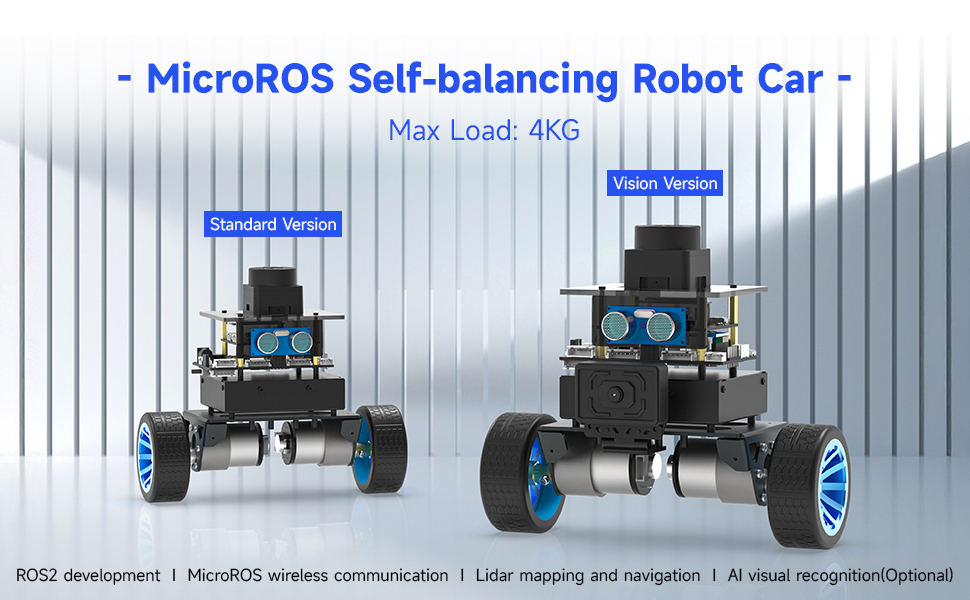01.Introduction
02.Assembly tutorial
03.Preparation
04.ROS-WiFi module configuration
05.Quick start control
06.ROS+OpenCV course
07.Mediapipe course
08.Robot basic course
09.Lidar course
10.Robot visual interaction
- 1.Color tracking
- 2.Object recognition and tracking
- 3.Face recognition tracking
- 4.Autonomous driving line patrol
- 5.QR code motion control
- 6.Gesture control car movement
- 7.Palm control car movement
- 8.Gesture control car action group
- 9.Palm recognition and tracking
- 10.Human body posture recognition and tracking
11.Multi-machine course
12.STM32 balancing case
- 01.MDK-ARM installation
- 02.STM32CubeIDE installation
- 03.Common driver installation
- 04.Download the program
- 05.MDK-ARM project usage
- 06.Program simulation
- 01.Project creation
- 02.LED Control(GPIO)
- 03.Buzzer control(GPIO)
- 04.Button control(EXTI)
- 05.Serial communication(USART)
- 06.Voltage detection(ADC)
- 07.Basic timer(TIM)
- 08.Universal timer(TIM)
- 09.Advanced Timer(TIM)
- 10.I2C Communication(I2C)-OLED
- 11.SPI communication(SPI)-2.4G handle
- 12.Independent Watchdog (IWDG)
- 14.DMA-USART
- 15.DMA-I2C
- 01.Battery voltage detection (ADC)
- 02.Ultrasonic module-measuring distance (TIM)
- 03.Motor drive+encoder (TIM)
- 04.OLED Data-Display(I2C)
- 05.MPU6050-Data Read (I2C)
- 01.PID basic concept
- 02.PID example analysis
- 03.P, PI, PD controller theory
- 04.Position PID
- 05.Incremental PID
- 06.Cascade PID
- 07.Balance principle of car
- 08.Car upright control (PD)
- 09.Car speed control (PI)
- 10.Car steering control (PD)
- 11.Got angle and angular velocity (DMP algorithm)
- 12.Got angle and angular velocity (Kalman filter algorithm)
- 13.Got angle and angular velocity(Complementary filter algorithm)
- 01.Car parameter adjustment
- 02.Ultrasonic obstacle avoidance
- 03.Ultrasonic follow
- 04.Bluetooth remote control
- 05.Load balance
- 06.Radar obstacle avoidance
- 07.Radar guard
- 08.Radar follow
- 09.Radar patrol
- 10.Radar wall following go in a straight line
- 11.Radar tracking wall multiple walls
- Balance car LQR high-level control
- 01.Overall circuit design
- 02.STM32 minimum system
- 03.Serial port circuit design
- 04.Power circuit design
- 05.MPU6050 Circuit Design
- 06.Motor drive circuit design
- Balance car mathematical model
01.Environment construction and development
02.STM32 getting started course
03.STM32 expansion course
04.Robot car PID control course
05.Robot car basic course
06.Robot car LQR control
07.Circuit design
08.Mathematical model
13.Linux basic course
- 1.Introduction to Linux system
- 2.Ubuntu file system
- 3.Ubuntu common commands
- 4.Ubuntu common editors
- 5.Ubuntu software operation commands
- 6.Virtual machine installation
- 7.SSH remote control
- 8.VNC remote control
- 9.Transfer files remotely
- 10.Driver library and communication
- 11.Static IP and hotspot mode
- 12.Bind device ID
- 13.Capacity expansion and resource allocation
- 14.Update system software sources
- 15.Set root user password
- 16.sudo free password
- 17.Connect to WiFi network
- 18.View system version
- 19.Customized service management
- 20.Back up system image
14.Docker course
15.ROS2 basic course
- 1.Introduction to ROS2
- 2.ROS2 install Humble
- 3.ROS2 development environment
- 4.ROS2 workspace
- 5.ROS2 function package
- 6.ROS2 node
- 7.ROS2 topic communication publisher
- 8.ROS2 topic communication subscriber
- 9.ROS2 service communication server
- 10.ROS2 service communication client
- 11.ROS2 action communication server
- 12.ROS2 action communication client
- 13.ROS2 custom interface message
- 14.ROS2 parameter service case
- 15.About ROS2 meta-function package
- 16.ROS2 distributed communication
- 17.ROS2 DDS
- 18.ROS2 time related API
- 19.ROS2 common command tools
- 20.ROS2 rviz2 use
- 21.ROS2 rqt toolbox
- 22.Python implementation of ROS2 launch
- 23.ROS2 launch xml.yaml implementation
- 24.ROS2 recording and playback tool
- 25.About ROS2URDF model
- 26.About ROS2 Gazebo
- 27.About ROS2 coordinate transformation TF2
- 28.ROS2 coordinate transformation TF2 case
Download

